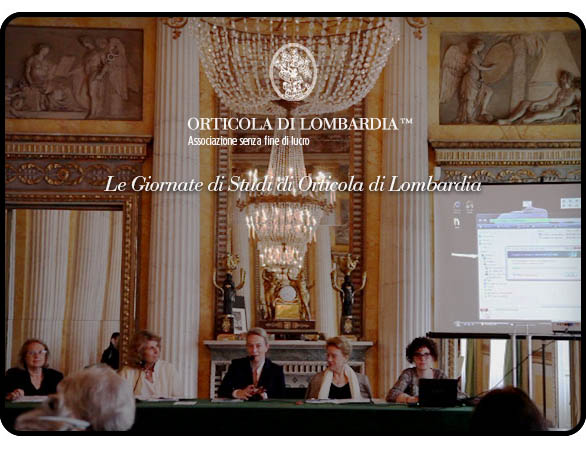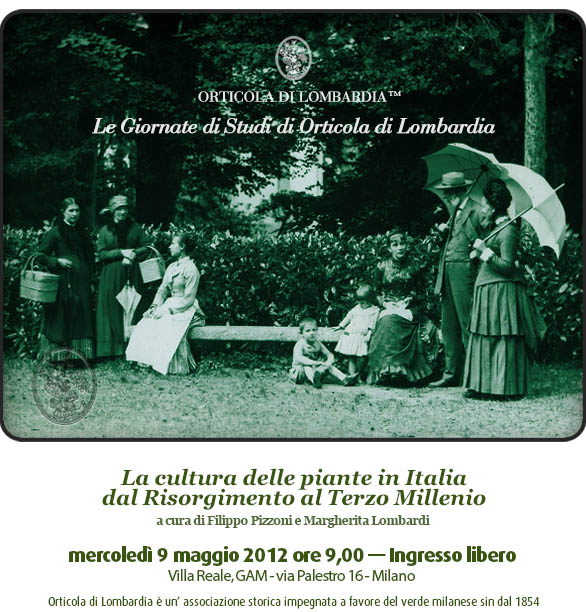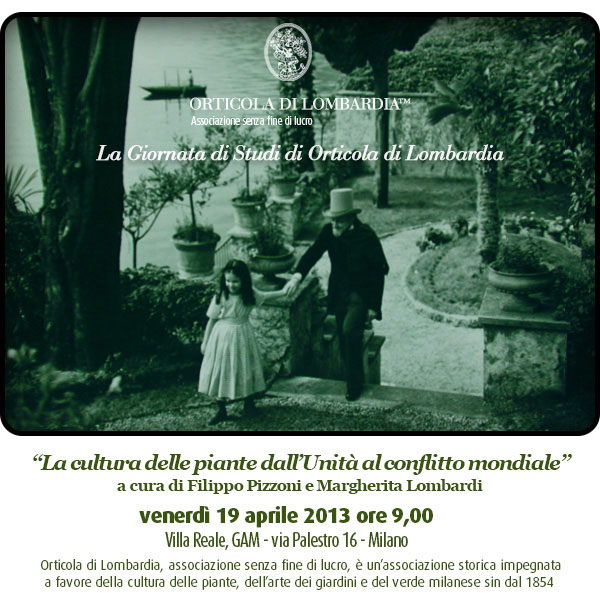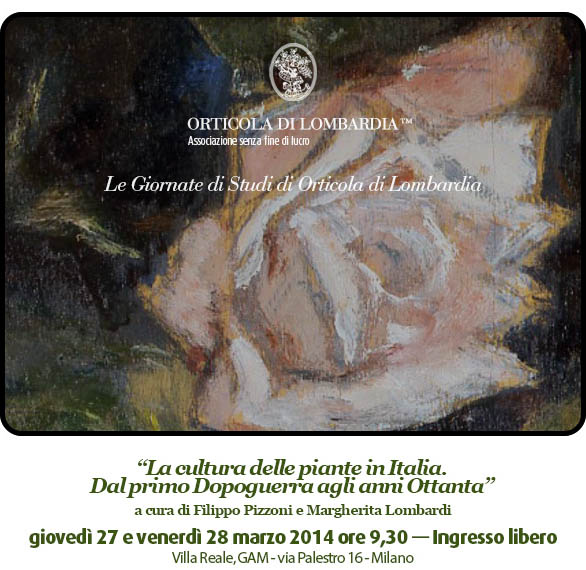2017-2020 | Lombard Horticultural Society Study Days
A new four-year cycle of “Study Days” started in 2017.
The next meetings program conducted by Filippo Pizzoni and Margherita Lombardi for Orticola di Lombardia will take place on february 14th & 15th, 2020.
Learn more… (Italian only) Orticola di Lombardia’s Study Days 2020
Rescue mission, endangered plant species
We were lucky enough to have Carlos Magdalena as one of our super guest presenting “Rescue mission, endangered plant species”
1.6 | Carlos Magdalena — Rescue mission, endangered plant species

Lombard Horticultural Society Study Days — 2012-2015
“Plant Culture in Italy, from the Risorgimento to the Third Millennium”
by Filippo Pizzoni and Margherita Lombardi for Orticola di Lombardia
“GAM”, the Modern Art Gallery in Milan hosts “The Study Days” of the Lombard Horticultural Society, a philanthropic event for the benefit of the Milanese community to share knowledge and significant data from the history of plant culture in Lombardy and Italy. Free admission for everyone.

Plant culture in Italy
The culture of plants and gardening has deep roots in our country, due to historic, artistic and natural contributing factors, which have witnessed the development of a great agricultural tradition in Italy, and the creation of an incredible historic artistic garden heritage, the destination of cultured tourism, with important botanical collections and excellent horticultural production highly esteemed worldwide.
The Orticola Study Days, a multi-disciplinary approach
The multi-disciplinary approach in fact aims to stimulate dialogue between different experiences and fields of study, which help to understand the evolution of such an important part of Italian culture, to analyse as many aspects as possible in order to formulate a general picture, with the aid of historic documents and works of art present in the rich heritage of civic collections.
The Study Days are aimed at students, professionals in the field, enthusiasts and scholars of the various disciplines to stimulate an exchange between different fields of knowledge, which help in understanding better the evolution of plant culture in Italy.
Development of the Programme over the years
2012 — “Plant culture in Italy from 1700 to Unification”

Beginning with pre-unification Lombardy, the first edition dealt with the passage from Enlightenment encyclopaedic culture to the scientific and pragmatic aspect. The introduction of an infinity of new plants and the fashion stemming from beyond the Alps showed a new way of making gardens while in Milan the first interventions in the city landscape were conceived in an environment distinguished by such impassioned botanists as Luigi Sacco, Luigi Castiglioni, Ercole Silva and Alessandro Manzoni.
2013 — “Plant culture from Unification to the First World War”

Plant culture developed during this time of great revival between the Unification of Italy and the first world war: many new public parks and gardens were conceived with backup from the important journeys of plant hunters, while professional horticultural production was established and important associations and publications flourished. A constantly growing interest is reflected in all the artistic forms, and the great botanical passion of Giuseppe Verdi, an expert gardener on his property at Sant’Agata, was celebrated during the bicentenary of his birth.
2014 — “From the first postwar period to the 1980s”

The leading figure of the time immediately after the first world war was Gabriele D’Annunzio who described plants with the accuracy of an expert in his writings. This period witnessed the revival of the so-called Italian style while, after the second world war, Italy produced a landscape designer of international calibre: Pietro Porcinai. Private gardens began to open to the public in the 1950s and flowers and plants began to inspire fashion. This crescendo culminated in the 1980s, when discussions on plants and gardens resurfaced in the work of Ippolito Pizzetti and specialised publications.
2015 — “From the end of the 1900s to Expo”

The latest edition of this four year programme deals with the many themes that consider plant culture to be a very fashionable topic since the end of the 1980s.
Which are the new professions linked to plants? What are the risks of globalisation? Which are the topics of urban horticulture and communications in the field? Which are the new leanings in the management of historic gardens or the design of urban parks? Three days of meetings and talks with the greatest experts in the sector to answer all these questions, and sum up the state of the art of green culture in Italy and look into the future that we can only surmise.
Subjects pertinent to the Orticola Study Days
- The people: academics and scholars, enthusiasts and amateurs.
- Artists and men of letters committed to the culture of plants and gardens.
- Schools teaching horticulture, gardening and landscape.
- Open-air events, festivals and shows.
- From horticultural shows to show markets.
- Literature and manuals on horticulture and agronomy.
- Gardening magazines, seed and plant catalogues
- Portrayals in major and minor arts and popular iconography.
- Archival documents and materials.
Topics and speakers over the years | Year 2012
— Fringes of the debate on Landscape Gardens in Italy between the end of the Ancien Régime and the Unification of Italy
Margherita Azzi Visentini ~ Lecturer on the History of Architecture, Milan Polytechnic
— The colour of dye plants in pre-Unification factories
Paola Barzanò ~Lecturer on Decoration, Florence University
— The Pavia and Brera
Botanical Gardens between the end of the eighteenth century and the beginning of the nineteenth
Agnese Visconti ~ Science and nature historian
— Travellers and plant hunters, an introduction to exotic species
Filippo Pizzoni ~ Landscape architect and garden historian
— The camellia from East to West: the role of Lombard aristocrats in its diffusion in Italy
Andrea Corneo ~ President Italian Camellia Society
— Leopold Pollack, garden architect, between Neoclassicism and the Enlightenment
Ginevra Agliardi ~ Art historian and photographer
— Going into gardens.
Pictures and societies from the Ancien Régime to the Risorgimento
Stefano Zuffi ~ Art historian
— Strolls and almanacs, Monza Royal Palace and the Traversi Garden in Desio
Franco Giorgetta ~ Landscape Architect
— Botanical-agrarian establishments in pre-Unification Italy
Gianpiero Fumi ~lecturer in Economic history, Sacred Heart Catholic University
— Alessandro Manzoni on agronomy, botany and nomenclature
Gianmarco Gaspari ~ Director of the National Centre of Manzoni Studies in Milan
— Luigi Villoresi and Giovanni Casoretti: great gardeners, prolific plant breeders
Andrew Hornung ~ Historian
The painted flowers of Francesco Hayez: which species and which stories
Luca Fadini ~ Botanic historian
Topics and speakers over the years | Year 2013
— Plant hunting trips and the progress of botany in Italy
Enrico Banfi and Agnese Visconti
— The history of the Ingegnoli nurseries, botanical trips and illustrated catalogues
Francesco Ingegnoli
— The native of Roncole.
Giuseppe Verdi «peasant» in the bicentenary of his birth, 1813 – 1901
Marta Isnenghi
— The notebooks of a grafter from Valtellina: Andrea Credaro (1831-1888)
Augusto Pirola and Nella Credaro
Giveaway nature.
Plants and flowers in commercial picture cards between 1800 and 1900
Daniele Fazio
— The evolution of several alcoholic beverages produced in Italy and their links to the land
Paolo Fantozzi
— Lombard horticulture from the Unification of Italy to the First World War
Tommaso Maggiore
— Photography: in the beginning were plants
Silvia Paoli
— The expressiveness of Art Nouveau flowers and lines
Lucia Impelluso
— Private collecting and passions: the Burcina Park
Franco Giorgetta ~ Architect and Guido Piacenza
Glasshouses and winter gardens: the culture and cultivation of plants in the second half of the 1800s
Sabina Villa
— Exoticism and colour: plants for mosaiculture
Luca Fadini
— The Language of flowers
Filippo Pizzoni
Topics and speakers over the years | Year 2014
— In 1931 ‘il Giardino Fiorito’ was launched by the Italian Friends of Flowers Society
Franca Gambini
— Sixty years of Italian rose breeders. 1920-1980
Michela Mollia
— The garden of the poet soldier. D’Annunzio and the Vittoriale degli Italiani
Federico Simonelli
— The fruit of passion: the Ninfa garden
Giuppi Pietromarchi
— The revival of the Italian garden after the 1920s
Annamaria Conforti Calcagni
— The English in Italy
Filippo Pizzoni
— Cecil Pinsent and Italian gardens in the XXth century: revival or new style?
Giorgio Galletti
— Flower growing in Italy
Tito Schiva
— Plants and landscape in Pietro Porcinai’s projects
Maria Pia Cunico and Luigi Latini
— 1920 -1980. Sixty years of nurseries and gardens
Francesco Mati
— Plant hunters. The history of the Toscolano Maderno Botanical Garden
Pia Meda
— Plants and flowers in Italian fashion: from the 1920s to the 1980s
Virginia Hill
— Flowers and plants as jewels
Françoise Izaute
— Orticola in the city.
Milan in bloom, the Xth Triennial and the 1959 exhibition on Lombard Gardens
Marta Isnenghi
— Historic gardens open to the public. The Borromean Islands
Vitaliano Borromeo
— Plants and flowers on the Italian table
Gualtiero Marchesi
— Gardens also need words. From the Ornitorinco to Gardenia
Francesca Marzotto Caotorta
Topics and speakers over the years | Year 2015
30 years of Plant culture in Italy
— Boscoincittà – a forty year-old innovation
Luisa Toeschi, President Italia Nostra Northern Milan.
— Alien plants
Enrico Banfi, former Director of the Milan Natural History Museum.
— Seed banks for the preservation and improvement of plant biodiversity
Graziano Rossi, Pavia University.
— Biodiversity, agriculture and EXPO
Marco Fabbri, President of the Association of Agronomists and Foresters in Milan.
— Italian botanical gardens. The situation in Lombardy
Pia Meda, Journalist
— Between fashion, forgetfulness and future: how plants and gardens change
Ermanno Casasco, Landscape gardener.
— Specialised nurseries and flower shows in Italy
Mimma Pallavicini, Journalist.
— Showing plants and discussing gardens
Francesca Marzotto Caotorta, garden designer and writer.
— Designing gardens in Italy: new trends
Patrizia Pozzi, Landscape Architect.
— Green publications at the outset of the third millenium
Emanuela Rosa-Clot, Editor of Gardenia
The green culture in Italy, opportunities and prospects
— Restoring historic gardens: summing up the Charter of Florence
Giorgio Galletti, former Superintendent of Florentine Architectural heritage.
— From paradise to hell: the “Golden Valley” of Palermo pillaged by the construction boom
Giuseppe Barbera, Palermo University.
— Ninfa and Pantanello Park, the restoration of a landscape
Lauro Marchetti, Director of the Ninfa Garden Natural Monument.
— Pleasure villas and historic gardens in Lombardy: a heritage to manage and nurture
Laura Sabrina Pelissetti, President of Regis, the Historic Gardens Network.
— Managing a green masterpiece: the Borromean Islands
Gianfranco Giustina, Curator of the gardens on the Borromean Islands.
— Plant culture and its communication
Filippo Pizzoni, Lombard Horticultural Society.
— Why do Italians hate trees?
Francesco Ferrini, Italian Arboriculture Society.
— Roots: the psyche of plants
Donato Chiatantea, Università degli Studi dell’Insubri.
— The importance of research in Italian floriculture
Elisabetta Margheriti, Commercial Director Torsanlorenzo Gruppo Florovivaistico.
— Plants “Made in Italy”, exportation and great projects
Francesco Mati, President of the National Floriculture Federation, Confagricoltura.
— The new structure of agricultural farms:
between multi-functionality and sustainable agriculture
Giovanni Sala, Councillor of the Associazione 100 Cascine (100 Farms Association).
The green, a cultural topic to adjust, implement, communicate
— “Città del Cavolo”:
comparing community allotments in Milan and Berlin – film screening
Paola Longo and Salvatore Laforgia, Filmmakers.
— Creating urban parks, reinventing familiar landscapes
Anna Lambertini, limes landscape architecture.
— The culture of landscape and the development of a profession
Luigi Latini, IUAV University Venice.
— The landscape designer in Italy today
Matilde Marazzi, Alessandro Ferrari, AIAPP Lombardy.
— The agronomist’s job. In the city!
Laura Gatti, Università degli Studi, Milan.
— Communicating landscape projects
Novella Cappellettie, Editor Paysage.
